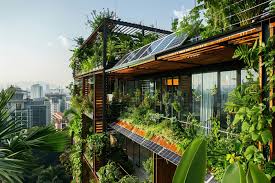Sustainable living is rapidly becoming a priority for homebuyers, renters, and developers alike. In London, where urbanisation and environmental concerns are pressing, eco-friendly developments are increasingly shaping the real estate market. From energy-efficient buildings to green spaces and smart technologies, these developments are not only addressing environmental challenges but also offering long-term financial benefits, according to estate agents in London. Here’s a closer look at how London’s eco-friendly developments are influencing the future of real estate in the city.
1. Growing Demand for Sustainable Housing
Changing Buyer Preferences
Eco-consciousness is rising among London’s homebuyers and renters. People are increasingly prioritising sustainability in their decision-making, seeking homes that minimise environmental impact and reduce energy consumption.
- Millennials and Gen Z Buyers: Younger generations, particularly millennials and Gen Z, are driving demand for eco-friendly housing. These buyers are more likely to consider energy efficiency, carbon footprint, and the use of sustainable materials when choosing a home.
- Health and Well-Being: Sustainable developments that focus on natural light, good ventilation, and non-toxic materials are appealing not only for their environmental benefits but also for their positive impact on health and well-being.
Energy Efficiency as a Key Selling Point
Energy efficiency is a top priority for those looking to lower their carbon footprint and reduce energy costs. Homes with high energy efficiency ratings are becoming more attractive to buyers and renters.
- Energy Performance Certificates (EPCs): Properties with high EPC ratings are in greater demand because they typically have lower utility bills and better insulation. Homebuyers are increasingly using these certificates as a deciding factor when purchasing homes.
- Government Incentives: As the UK government pushes towards achieving its net-zero emissions goal by 2050, properties that meet high environmental standards may benefit from future tax incentives, grants, or reduced property taxes, further increasing their appeal.
2. Eco-Friendly Technologies and Smart Homes
Smart Energy Solutions
The integration of smart home technology is becoming a cornerstone of sustainable living in London’s real estate market. Eco-friendly developments are incorporating technology that helps homeowners monitor and manage their energy consumption more effectively.
- Smart Meters: These allow homeowners to track their energy use in real-time, encouraging more efficient energy consumption. Many developments now include smart meters as standard, making it easier for residents to control heating, lighting, and appliances.
- Solar Panels and Renewable Energy Sources: Solar panels and other renewable energy systems are becoming common in eco-friendly developments. Not only do these technologies reduce carbon emissions, but they can also lower energy costs significantly, providing long-term savings for homeowners.
Sustainable Water Management
With increasing pressure on London’s water resources, sustainable water management is a growing focus in new developments. From water-saving appliances to rainwater harvesting systems, developers are using innovative solutions to reduce water consumption.
- Greywater Systems: Some developments are installing greywater recycling systems, which collect and treat wastewater from showers, sinks, and washing machines for reuse in toilets or landscaping, reducing overall water use.
- Rainwater Harvesting: Harvesting rainwater for use in gardens or even in-home water systems is another strategy that eco-friendly developments are adopting to reduce demand on London’s water supply.
3. Green Spaces and Biodiversity
Urban Green Spaces
One of the most visible trends in London’s eco-friendly developments is the integration of green spaces. Green roofs, community gardens, and public parks are increasingly being incorporated into new projects, providing both environmental and social benefits.
- Improving Air Quality: Green spaces help absorb carbon dioxide and other pollutants, improving air quality in dense urban environments. This is especially crucial in London, where air pollution remains a significant concern.
- Promoting Well-Being: Research has shown that access to green spaces promotes physical and mental well-being. Developments that offer gardens, parks, or rooftop green spaces are highly attractive to homebuyers looking for a balance between city life and nature.
Enhancing Biodiversity
Eco-friendly developments are also focusing on enhancing biodiversity by creating environments that support local wildlife. Developers are incorporating features such as wildlife corridors, pollinator-friendly plants, and habitats for birds and insects.
- Biodiverse Roofs and Walls: Green roofs and living walls are being used to promote biodiversity. These features help create habitats for birds, insects, and other wildlife while improving insulation and reducing urban heat island effects.
- Nature-Inclusive Design: New developments are increasingly using nature-inclusive designs that incorporate trees, shrubs, and other plants that support biodiversity while enhancing the aesthetic appeal of the area.
4. The Role of Developers and Government Policy
Leading Eco-Developers in London
Several key developers in London are leading the way in sustainable building practices. These companies are setting new standards for energy efficiency, green design, and sustainability in residential and commercial developments.
- Berkeley Group: Known for their commitment to sustainability, Berkeley Group has implemented ambitious targets to reduce carbon emissions, energy use, and water consumption in their developments. Their EcoWorld brand focuses specifically on environmentally-friendly homes.
- Lendlease: Lendlease’s projects, including their work on the regeneration of Elephant & Castle, aim to create sustainable, low-carbon communities. Their developments prioritise energy efficiency, water conservation, and green spaces.
Government Initiatives and Policies
Government policy is playing a pivotal role in shaping the future of sustainable developments in London. With a focus on reducing carbon emissions and promoting eco-friendly living, regulations are pushing developers to adopt greener practices.
- Net Zero Targets: The UK government’s commitment to achieving net-zero emissions by 2050 is influencing the design and construction of new developments. Regulations now require that new homes meet higher energy efficiency standards, and developers are being encouraged to incorporate sustainable materials and technologies.
- London Plan: The London Plan, the city’s strategic development framework, prioritises sustainability in new housing developments. It outlines requirements for energy efficiency, water conservation, and environmental performance, ensuring that new buildings contribute to the city’s long-term sustainability goals.
5. Impact on Property Values
Higher Property Values for Sustainable Homes
As eco-friendly features become more desirable, homes with sustainable designs and technologies are likely to see increased property values. Buyers are willing to pay a premium for homes that offer long-term savings on energy and water bills, as well as those that contribute to a lower carbon footprint.
- Market Differentiation: Homes with strong sustainability credentials differentiate themselves in the marketplace, often selling faster and at a higher price than conventional properties. As awareness of environmental issues grows, demand for these homes is expected to rise.
- Energy Efficiency and Resale Value: Homes with high energy efficiency ratings (A or B on the EPC scale) are more likely to retain or increase in value over time. As energy costs rise, the appeal of homes that offer lower bills will continue to grow.
Long-Term Investment Potential
Sustainable homes not only hold their value but are increasingly seen as a solid long-term investment. Eco-friendly developments often attract higher-end buyers and tenants, creating strong rental demand and the potential for future capital appreciation.
- Attractive to Investors: Properties in eco-friendly developments appeal to a growing segment of environmentally-conscious investors. These properties often yield higher rents due to their desirability among tenants looking for sustainable living environments.
- Reduced Maintenance Costs: Energy-efficient homes with durable, sustainable materials tend to have lower long-term maintenance costs, making them a more cost-effective investment.
Conclusion
The rise of eco-friendly developments is transforming London’s real estate market, as sustainable living becomes a priority for developers, homebuyers, and investors. With features such as energy efficiency, smart technologies, green spaces, and biodiversity-focused designs, these developments are not only addressing environmental concerns but also providing long-term financial benefits. As government policies and market demand continue to drive sustainability forward, eco-friendly homes will play an increasingly significant role in shaping the future of London’s real estate landscape.







